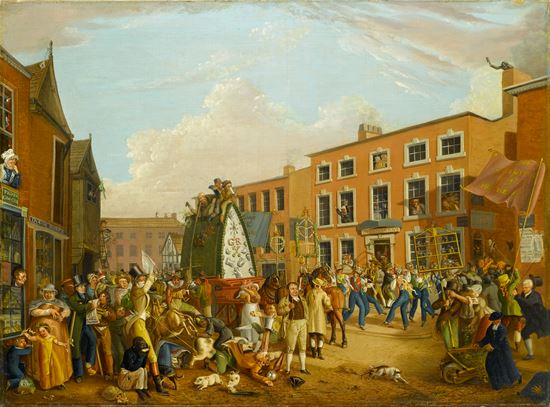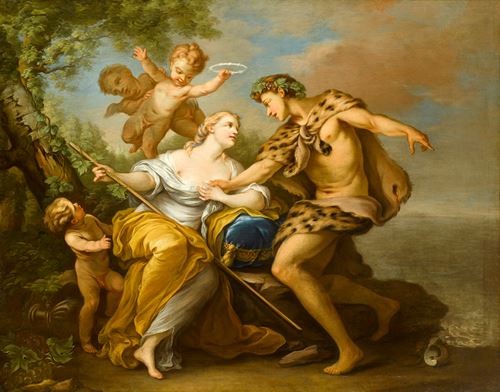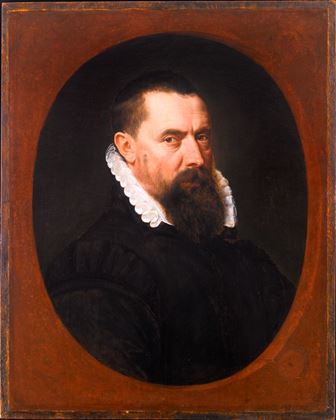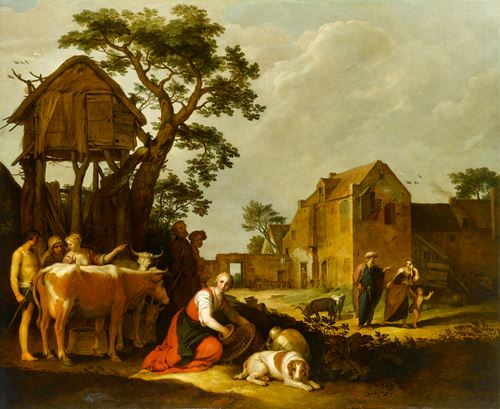lexander Wilson
(Manchester 1803 - 1846)
Rush Bearing at Long Millgate, Manchester
signed and dated ‘A. Wilson/Pinxt 1821’ (lower left on artists sketch pad)
oil on canvas
83.5 x 112 cm (33 x 44 in)
This painting, full of character, depicts the ancient folk custom of ’Rush Carting‘, taking place along the narrow street of Long Millgate in Manchester. According to local history, the tradition is pre-Christian but was adopted into the church calendar, in rural Northern England, in the early 19th Century. In the days when church floors were earthen, rushes would be gathered and strewn on the ground in autumn as insulation for the winter months. Rush carts were built to carry these rushes from village to village and along the way took part in an annual festival in celebration of the church’s Saint’s day.
In the area of Saddleworthshire, east of Manchester, nearly every hamlet or village built a rush cart to compete with their neighbours to create the best and most energetic display. Men, boys and, on occasion horses, would pull up to two tonnes of rushes loaded onto each cart, secured with just four rods on each corner, bent and tied at the top. The load was then topped with a small tree and an elected ’jockey‘. The displays were accompanied by music, singing, dancing and other entertainments and would often attract the entire village onto the street, as Alexander Wilson has depicted in this painting.
The picture is full of interest and many well-known residents are represented among the group. The Rev. Joshua Brookes is seen to the lower right about to strike a college boy, presumably because the latter was neglecting his duties by being there. Close by is Gentleman Cooper, a noted pedestrian of the day, the artist himself to the left, and a portly publican, Henry Slater. The Rush Cart, fronted with silver plate, is drawn by brightly decorated horses, and is accompanied by a group of Morris dancers, who are giving an exhibition of their skill in front on the inn, from the windows of which some excited individuals are shouting.
The whole scene is resplendent with local character, from the unruly mob to the right and the topers riding on top of the cart, to the disobedient farm animals, running loose among the crowd, creating a hint of chaos amid the celebration. The vibrancy of the composition brings a sense of the occasion to every viewer making this depiction a unique image of the heritage of the North West.
Towards the end of the 19th century, earthen floors began to be replaced by stone and the once necessary practice of spreading rushes became an outdated tradition. Rush Carts continued to visit the churches, selling the rushes to the landlords to be used as animal bedding, however in 1921 the police finally put a stop to the displays following complaints about drunkenness and one or two deaths. In 1975 The Saddleworth Morris Men revived the practice and have been building and parading Rush Carts in the Manchester area ever since.
Born in 1803 into a local family of notable talent, Alexander Wilson was a self-taught artist and song writer. He was well known for his paintings of successful racehorses and sportsmen such as The Manchester Cockpit. In his best known work Rush Bearing at Long Millgate, Manchester, he chose Long Millgate as the setting, with the cart shown passing the Manchester Arms. In addition to his considerable talent as a painter he was a succesful song writer, his numerous abilities summarised in a section of his epitaph which reads: ‘And they who know they varied powers, / May well remember thee.’¹
We are extremely grateful to Andrew Loukes of the Manchester Art Gallery, Richard Hankinson of The Saddleworth Morris Men and Sem Seaborne of The Icknield Way Morris Men for their kind assistance in preparing this catalogue entry.
¹ Swindells, lit., p. 62.
"disposed of in a raffle for sixty guineas";
collection of Mr. Roger Wilson, Woodford, Cheshire (until at least 1881).
The Songs of the Wilsons, ed. John Harland (Whittaker & Co., London, 1865), p.9;
Richard Wright Procter, Memorials of Manchester Streets, (Thomas Sutcliffe, Manchester, 1874), pp.36-37.
The Living Age,vol. 149, iss. 1931, June 1881,p.751;
Alfred Butron, Rush-bearing: An Account of the Old Custom of Strewing Rushes; Carrying Rushes to Church; the Rush-Cart; Garlands in Churches; Morris-Dancers; the Wakes; the Rush (Brook & Chrystal, Manchester, 1881), pp. 63-64, illustrated;
Thomas Swindells, Manchester Streets and Manchester Men, vol. IV (J. E. Cornish Ltd., Manchester, 1908), pp.57-58, 61.
Engraved:
c.1836.
This painting, full of character, depicts the ancient folk custom of ’Rush Carting‘, taking place along the narrow street of Long Millgate in Manchester. According to local history, the tradition is pre-Christian but was adopted into the church calendar, in rural Northern England, in the early 19th Century. In the days when church floors were earthen, rushes would be gathered and strewn on the ground in autumn as insulation for the winter months. Rush carts were built to carry these rushes from village to village and along the way took part in an annual festival in celebration of the church’s Saint’s day.
In the area of Saddleworthshire, east of Manchester, nearly every hamlet or village built a rush cart to compete with their neighbours to create the best and most energetic display. Men, boys and, on occasion horses, would pull up to two tonnes of rushes loaded onto each cart, secured with just four rods on each corner, bent and tied at the top. The load was then topped with a small tree and an elected ’jockey‘. The displays were accompanied by music, singing, dancing and other entertainments and would often attract the entire village onto the street, as Alexander Wilson has depicted in this painting.
The picture is full of interest and many well-known residents are represented among the group. The Rev. Joshua Brookes is seen to the lower right about to strike a college boy, presumably because the latter was neglecting his duties by being there. Close by is Gentleman Cooper, a noted pedestrian of the day, the artist himself to the left, and a portly publican, Henry Slater. The Rush Cart, fronted with silver plate, is drawn by brightly decorated horses, and is accompanied by a group of Morris dancers, who are giving an exhibition of their skill in front on the inn, from the windows of which some excited individuals are shouting.
The whole scene is resplendent with local character, from the unruly mob to the right and the topers riding on top of the cart, to the disobedient farm animals, running loose among the crowd, creating a hint of chaos amid the celebration. The vibrancy of the composition brings a sense of the occasion to every viewer making this depiction a unique image of the heritage of the North West.
Towards the end of the 19th century, earthen floors began to be replaced by stone and the once necessary practice of spreading rushes became an outdated tradition. Rush Carts continued to visit the churches, selling the rushes to the landlords to be used as animal bedding, however in 1921 the police finally put a stop to the displays following complaints about drunkenness and one or two deaths. In 1975 The Saddleworth Morris Men revived the practice and have been building and parading Rush Carts in the Manchester area ever since.
Born in 1803 into a local family of notable talent, Alexander Wilson was a self-taught artist and song writer. He was well known for his paintings of successful racehorses and sportsmen such as The Manchester Cockpit. In his best known work Rush Bearing at Long Millgate, Manchester, he chose Long Millgate as the setting, with the cart shown passing the Manchester Arms. In addition to his considerable talent as a painter he was a succesful song writer, his numerous abilities summarised in a section of his epitaph which reads: ‘And they who know they varied powers, / May well remember thee.’¹
We are extremely grateful to Andrew Loukes of the Manchester Art Gallery, Richard Hankinson of The Saddleworth Morris Men and Sem Seaborne of The Icknield Way Morris Men for their kind assistance in preparing this catalogue entry.
¹ Swindells, lit., p. 62.
"disposed of in a raffle for sixty guineas";
collection of Mr. Roger Wilson, Woodford, Cheshire (until at least 1881).
The Songs of the Wilsons, ed. John Harland (Whittaker & Co., London, 1865), p.9;
Richard Wright Procter, Memorials of Manchester Streets, (Thomas Sutcliffe, Manchester, 1874), pp.36-37.
The Living Age,vol. 149, iss. 1931, June 1881,p.751;
Alfred Butron, Rush-bearing: An Account of the Old Custom of Strewing Rushes; Carrying Rushes to Church; the Rush-Cart; Garlands in Churches; Morris-Dancers; the Wakes; the Rush (Brook & Chrystal, Manchester, 1881), pp. 63-64, illustrated;
Thomas Swindells, Manchester Streets and Manchester Men, vol. IV (J. E. Cornish Ltd., Manchester, 1908), pp.57-58, 61.
Engraved:
c.1836.




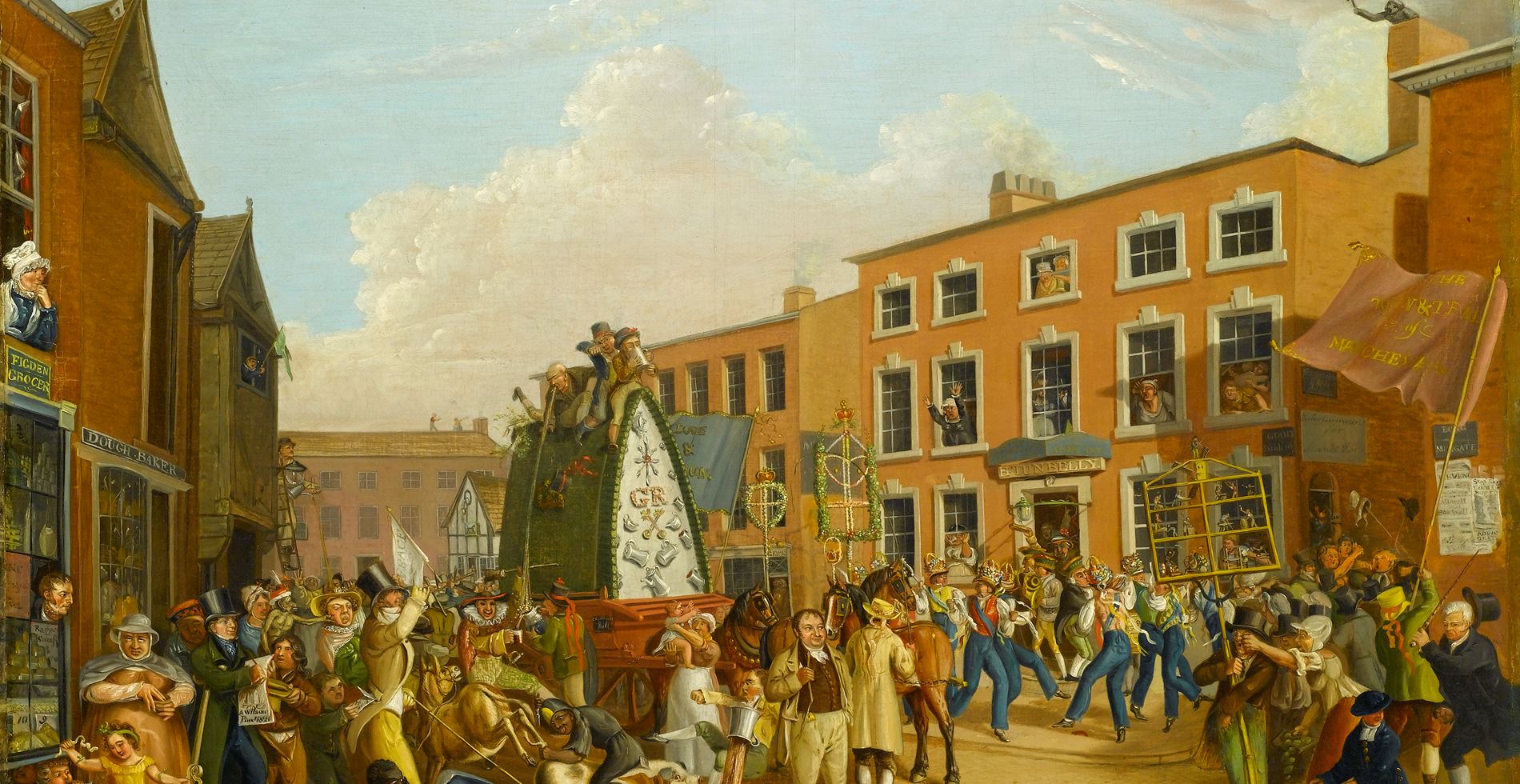
 contact
contact +44 20 7313 8040
+44 20 7313 8040


